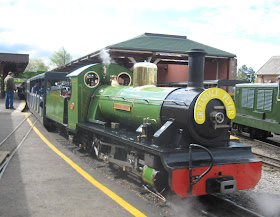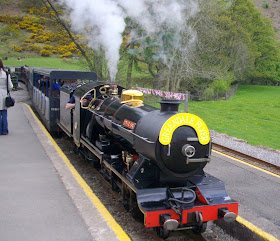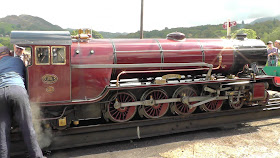In a nutshell
Gauge: 15"
Length: 7 miles
Opened: 1875 - 3' gauge (closed 1913)
1915 - 15" gauge
Location:
View Narrow Gauge Railways in a larger map
Dates of visits: 9 May 2010, 26 July 2013
Key Facts
- When the railway opened in 1875 it was 3' gauge.
- Its original purpose was primarily to transport iron ore from quarries and mines to the mainline railway at Ravenglass
- When it was given permission to carry passengers in 1876, it became the first public narrow-gauge railway in England
- The first incarnation of the railway closed in 1913 as the income from iron ore and passengers declined making the railway unviable
- The line re-opened as a 15" 'minimum gauge railway' in 1915 under the ownership of W. J. (Wynne) Bassett-Lowke and Robert Proctor-Mitchell who were interested in demonstrating the potential of 15" gauge as a commercial venture, based on the earlier work of Sir Arthur Heywood (see A Brief History of Minimum Gauge Railways)
- Initially, trains were hauled by one of Bassett-Lowke's 4-4-2 locomotives (Sans Pareil) which was a miniaturised version of a full scale standard gauge loco.
- More rolling stock was provided from Sir Arthur Heywood's Duffield Bank Railway, following his death in 1916.
- Whilst summer passenger tourist traffic was the mainstay of the line, it also transported granite from Beckfoot Quarry to a crushing plant at Murthwaite.
- The railway ran one of the first diesel locomotives in 1929
- The railway closed to traffic during the years of the Second World War
- In 1959 the railway was threatened with closure but was bought by a preservation society in 1960 which has remained in ownership ever since
- Around 120,000 passengers are carried on the railway each year
- The railway is open throughout the year though there is usually a brief closure for maintenance during the month of January
Route
My Impressions
I have visited and travelled on the Ravenglass & Eskdale (L'al Ratty) on several occasions but my first visit in 2010 ,laid the foundations for my desire to create this blog. It was my first attempt to properly document a visit.As we were staying with relatives not far from Ravenglass, we arrived at the station fairly early and so there was time to watch the trains being prepared for the day and have an opportunity to partake of one of the station cafe's fine breakfasts - which is somewhat of a feast.
 |
| River Mite was built by the Preservation Society in 1966 |
 |
| Originally built as a 2' gauge 0-4-0WT by Kerr Stuart in 1900 for Dundee gasworks, Bonnie Dundee is now an 0-4-2 tender engine |
We boarded the train and made our way down the line taking in the views as the train took the 1:55 gradients to the furthermost terminus at Dalegarth.
We spent a while at Dalegarth, watching the train movements and had a light lunch in the cafe which is situated in the station building.
Meanwhile, 2-8-2 River Esk arrived with a full train from Ravenglass. Built by Davy Paxman in 1923 to a design by the renowned Henry Greenly, she is a very impressive and powerful locomotive.
As there are turntables at each end of the line, the locos always run chimney-first up and down the line and the turning of the locos usually seems to attract a great deal of interest.
We then boarded the train and were fortunate enough to have a seat directly behind the locomotive.
After watching the arrival of River Irt, we made our way back up the line to Ravenglass.
As this was a special Postman Pat themed day, there were events organised at the stations for children and a busy schedule of trains running in each direction. There was plenty to see and do, for children and adults alike. It's unsurprising this this is one of the Lake District's leading visitor attractions.
Return visit - 26 July 2013
On arrival at Ravenglass Station, we exchanged the pre-booked ticket voucher which we had bought online for our tickets and then retired to the station café for their slap-up breakfast - which has become a bit of a tradition when we visit the line.While my wife ordered breakfast, I had a few minutes to wander around the station forecourt, where I discovered the outcome of the devastating fire which had led to difficulties for the railway in providing a full complement of locomotives.
However, the 15" narrow gauge railway community is close-knit and, thanks to loans of locos from the Bure Valley and the Romney, Hythe & Dymchurch, the railway has been able to continue running its services through the summer. Waiting in the station for the right of way was the Bure Valley loco, Wroxham Broad
Our loco was the RH&DR 4-8-2, Hercules but there was no time for a picture and so, with a slice of toast still in my hand, we boarded the train to set off up the valley.
The first part of the journey takes the train beside the estuary of the River Mite before turning inland to pass under the main A595 road beside which is Muncaster Mill - a request stop.
The line then begins a gentle ascent up the valley, winding its way through woodland and passing the site of the granite crushing plant at Murthwaite.
Sometimes trains pass each other at Irton Road, but not on this occasion - we passed the Up train at Miteside Loop.
After passing under the road bridge at Irton Road which was built to clear the height and width of the line's original 3' gauge trains, we continued our journey.
We chugged through The Green station which serves the community of Eskdale Green and climbed up Eskdale Valley, passing the site of Beckfoot Quarry .......
 |
| Model of Beckfoot Quarry in the museum at Ravenglass |
....... the source of the granite which was transported down the valley to the crushing plant.
After a stiff climb of 1:38, the train crossed the River Esk and pulled into Dalegarth Station where Wroxham Broad was awaiting the off.
As Hercules was too long to fit on to the turntable with her tender, they each had to be turned separately.
There was an opportunity to take a few shots of this impressive Greenly designed and Paxman built locomotive.
.... and watch the arrival of the next train behind the railway's 2-6-2 locomotive, Northern Rock, built in the line's workshops in 1976.
We decided to walk along the road down the valley to Eskdale Green, passing on the way the one of the line's B-B diesels, Douglas Ferreira, on its way up the valley.
By the time we reached The Green, Douglas Ferreira, was returning Up the line and so we flagged it down and boarded the train.
At Miteside Loop, we passed Northern Rock on the Down Train.
On arrival at Ravenglass, we visited the museum where there are some photos of the railway in its early days - such as this picture of Eskdale Green station when the railway was 3' gauge........
.... and this photo of Sir Arthur Heywood's 0-8-0T loco, Muriel running on the railway before she was converted into 0-8-2 tender loco River Irt.
After a quick snap of Douglas Ferreira, we hopped in the car and reluctantly left the railway behind.
As can be seen from both the visits. There is always plenty to see on the R&ER and there are plenty of walking routes which start and finish at stations along the line. The quality and range of food available at the cafés at each end of the railway is very good and the staff are happy to explain to visitors what they are doing and how the railway operates.
Hopefully, the locos which were affected by the fire will soon be back in service but it was interesting to see visiting locos hauling service trains.
Video
[In preparation]
































No comments:
Post a Comment